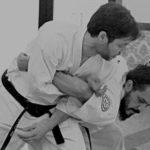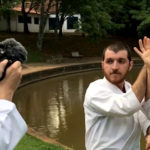The fighting methods of old style karate (Ryuukyuu toude 琉球唐手), currently not known by many but still recorded in the kata, were originally meant to be used in non-consensual violence. That is, karate was not for duels, nor street fights, neither sport matches, but essentially for self-defense.
The dynamics of self-defense physical violence is generally of close range (unless long range weapons are involved, but that is another matter for another discussion). The typical course of action will be as follows:
- If the threat is already present but the aggressor is still at a distance, you should try to de-escalate if possible (in order to avoid physical violence), and then escape;
- If you can’t de-escalate and escape, then the aggressor will inevitably close in to attack you (if he doesn’t, you just escape, remember?). So you’ll have to fight him close-range after all;
- If the aggressor’s maintains a distance, but you still can’t escape, you’ll want to be the one closing in to neutralize the threat (you can’t neutralize him from a distance, so you have to come close). Once again the fighting will be close range;
- If after your counter-attack (or maybe even after your preemptive attack) the aggressor gives you space and opportunity, you finally escape;
- If there’s still no opportunity of escaping (maybe because the aggressor successfully defended himself), you maintain the pressure upon him until you neutralize him. Keep attacking, and use the aggressor’s defensive actions against himself!
When you’re fighting in close range, not only you can properly attack, but also (if you’re properly trained) you can achieve great control over the aggressor’s movements, so you use those movements in your favor. And you stop attacking only when the aggressor is neutralized, so you can finally have an opportinity of escaping.
In the video, Muidokan founder Samir Berardo explains and demonsrates those concepts, through a typical and devastating kata application sequence. It was recorded in a Muidokan seminar carried out in 2019 in Rondônia/Brazil. Variations of that sequence are present in a great number of essential karate kata. Can you guess the kata moves or the kata names?
(Big thanks to Brazillian jiu jitsu master Aner Rosa, who participated in the demonstration with Muidokan founder Samir Berardo.)




Pingback: Defensive power of historical karate techniques in close range fighting - Muidokan
Pingback: Kakedameshi, historical teachings of karate and hontou bunkai – Muidokan Karate Kenkyukai
Pingback: What is old style karate? – Muidokan Karate Kenkyukai